The Noorderzon Festival is an international performing arts festival that took place in Groningen (Netherlands) from 18 to 28 August 2016. It presented several surprising and interesting features. It is a small international festival of theatre innovation (in number around sixty productions) compared to other summer festivals, but the very high quality of most of the international productions selected makes it outstanding. The artistic director is Marc Yeoman.
Besides the innovative theatrical and dance productions and installations, the festival also scheduled productions of more popular genres for a wider public, such as circus, puppet theatre, children’s theatre, film, and stand-up comedy. The festival also programmed a number of local and national productions that attract an important part of the public.
The theatre festival has become a popular festive week for the city. For ten days, productions are shown in fifteen venues in the city center, and in fourteen temporary venues in the Noorderplantsoen, a very pleasant garden in the north of the city. There are venues of different sizes specially constructed for the festival. Some are huge circus tents transformed into theatre venues; others are rectangular and some smaller circus venues. Finally, there are tiny venues formed by two containers, which can accommodate only a stage and a small audience. Some were set along the paths of the garden, allowing the audience to see a large number of small productions, performed sometimes by playgoers or by local professionals. For example, in one of these small spaces, I saw a charming little production of theatre shadows called Schemerding, by the high school students of the local actors’ school De Noorderlingen. Beside the venues, diverse facilities bars, coffee shops, restaurants are set up in the park, with their tables under the trees, attracting the city’s population.
Among the productions I saw, GUERRILLA, by the Spanish group El Conde de Torrefiel, was one of the most innovative and interesting (see my article about the Brussels Kunstenfestivaldesarts, also in this issue). It had the same form and was as surprising as it was in Brussels, with only a little difference that was due to the presence of fewer participants (40 instead of 100 in the last scene). The Noorderzon scheduled four other productions that were also in the Kunstenfestivaldesarts in Brussels (May 2016): While I was waiting by the Syrian director Omar Abusaada; the theatre-film Zvizdal by the group Berlin; Edit Kaldor’s Web of Trust; and Oblivion by Sarah Vanhee/CAMPO.
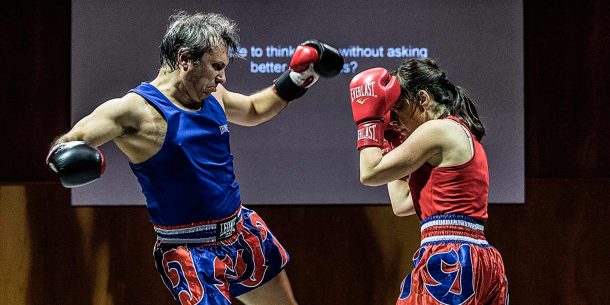
Claudia Dias’s Monday – Watch out for the right. Photo: courtesy of the Noorderzon Festival.
Cláudia Dias’ Monday – Watch out for the right was presented in a large church in the middle of the city, Der Aa-kerk. Under the ribbed vault a boxing ring was positioned and the public located around the ring. Above each side there was a screen where the translation of the Portuguese text was shown. The text was presented by a male voice while two performers, Claudia Días and the Spanish poet Pablo Fidalgo Lareo, fought for twelve rounds, without saying a word. Another performer sitting at one side played the referee controlling the time, ringing the bell, ending and indicating the start of a new round. The production was based on a loose and metaphorical relationship, but also very often on the contradiction between the text and the scenic movements. The text began by evoking the fight between George Foreman and Muhammad Ali in Kinshasa in 1974, and analyzing some of the circumstances of the fight, but also the nature of boxing itself. The narrator tackled diverse forms of violence in our world and in our lives, and also diverse injustices of the present world. The text followed a quite regular pattern. Each round began by developing a theme, to widen the reflection to its general consequences, with diverse associations. For example in the fourth round the narrator’s questions concerned the consequences of the benefits of capital; the sixth round dealt, among other topics, with moral conscience; the seventh asked about poverty across the world, about the need to hide what is really urgent, whispering the essential and shouting the superficial. On several occasions, at the end of a round a reflection was repeated: the need to ask better questions in order to obtain better results. In each round, the performers on stage changed something about their way of fighting, creating variations within the same action. For example, the first round looked more like training than a real fight, and this aspect was preserved in the overall production: it was not a real fight, but its representation with metaphorical meaning. Sometimes their fight seemed influenced by the questions, but most of the time it followed its own rhythm. The importance of the questions, their variety and the poetic aspect of the text made this production very attractive.
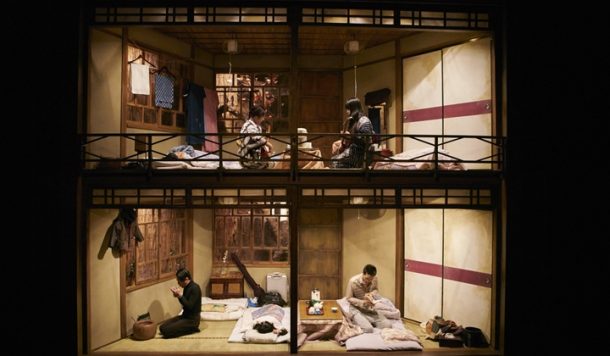
Niwa Gekidan Penino’s Avidya – The Dark Inn by Kuro Tanino. Photo: courtesy of the Noorderzon Festival.
Avidya – The Dark Inn, a play by Kuro Tanino, performed by the Japanese group Niwa Gekidan Penino, was a striking production. A strange pair of puppeteers, a small person and his son, reach a little inn in the Japanese mountains. The inn is beside a hot spring where all of the characters, the visitors and the locals (played by Mame Yamada, Takahiko Tsuji, Ichigo Iida, Bobumi Hidaka, Atsuko Kubo, Kayo Ishikawa, Hayato Mori) bathe and meet. The inn is called Avidya, meaning “delusion” in the Buddhist tradition, which is also one of the topics of the production. The arrival of the puppeteers deeply impresses the local inhabitants, including a “sansuke” (a profession that no longer exits) who takes care of the entrance to the hot spring and washes the bodies of the clients, a local man who is losing his sight, an old lady, and two young women. The performers provoke the most extreme reactions among the inhabitants, confronting their fears and their deepest, hidden desires. The production also shows the disappearance of a traditional world as the inn will be soon destroyed to build the Shinkansen, the high-speed train.
On a beautiful and very realistic revolving stage, the spectator goes into the inn. Beyond the entrance, the rooms are divided into two floors, where two simultaneous actions take place; in a third space, the characters get rid of their clothes to go into the hot spring, and finally they enter the hot spring itself with its steaming water. With precise acting the production shows the reactions, the differences of class of the inhabitants, and the delusion provoked by the puppeteers who finally perform in front of the locals showing great beauty in their production but also exposing the vulgarity and the lack of knowledge of the music of the two local women. For two hours, the realistic aspects of the set contrast with the fairytale story.
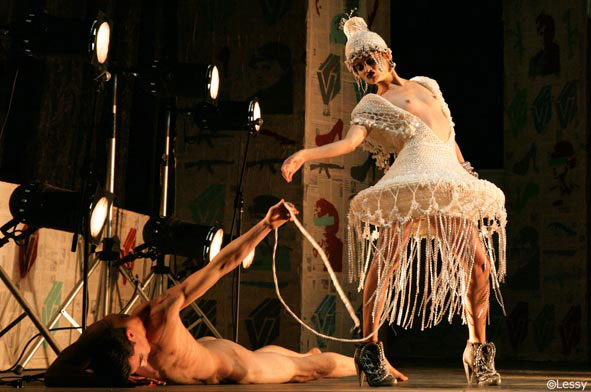
Teatro El Público’s Antigonón, un contingente épico by Rogelio Orizondo, directed by Carlos Días. Photo: courtesy of the Noorderzon Festival.
The excellent production Antigonón, un contingente épico, performed by the Cuban group Teatro El Público, with text by the playwright Rogelio Orizondo and directed by Carlos Días, presented a stunning although sometimes contradictory and polyphonic new version of the Antigone myth with five actors (Giselda Calero, Daysi Forcade, Luis Manuel Álvarez, Roberto Espinosa, and Linnet Hernández). More than giving a new version of the myth, the text uses the myth to speak about the Cuban revolution, in a very provocative way, mixing metaphorically the myth and its characters with Cuban situations. The text exalts the Cuban revolution; at the same time, the production showed, at the very least, the inadequacy between the discourse of the play and the contemporary situation. There was a gap between the discourse and what the audience saw on stage: The text is political and the aesthetics belong to the cabaret, denouncing false appearances. In the first image two actors and two actresses were naked on stage. Their nakedness seemed to indicate a desire to show a bold reality, with nothing to hide. The women were downstage, the men upstage, closer to each other than the actresses. Almost throughout the production they used the same scenic arrangement. An actor or an actress would speak directly to the audience illuminated by a circle of light, as in a cabaret production, while the rest of the stage was less illuminated. When she or he finished the discourse, all of the actors would move simultaneously, occupying the entire space. These rather rough movements corresponded to fragments of the text, stressing the separations within the flow of the poetic text. The actresses (most of the text was delivered by them) would leave the stage, change their clothes, and return. The fancy dress costumes left parts of their body naked and looking as if they belonged both to a cabaret production, and to what could be called an erotic carnival. The actresses spoke loudly most of the time, directly to the audience, with angry inflection. They spoke about the revolution, but at the same time they made sexually explicit gestures, creating a contradiction between the poetic text and the boldness and aggressiveness of the actors. Throughout the discourse they claimed freedom and sensuality for their own personal life. The parody reached many aspects of the discourse, utilizing some Cuban myths, but also some American clichés as when the two actresses dressed as two young boys with baseball caps, parodying their masculinity. In the same vein, a black actress appeared on stage wearing a red dress, then took off all her clothes and, naked, delivered before the public her speech with anger and strength. At the end of the production the two actors and the two actresses first dressed in the uniform of the Cuban communist youth, and then changed their clothes several times, very quickly, as if showing the superficiality of appearances.
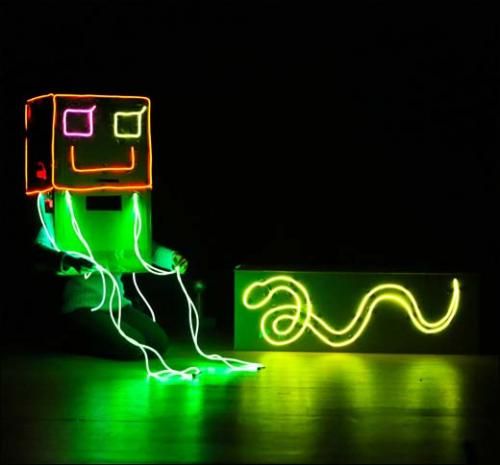
I have never done this before by Giuseppe Chico and Barbara Matijević. Photo: courtesy of the Noorderzon Festival.
I’ve never done this before, by Giuseppe Chico and Barbara Matijević, presented at the VRIJDAG Theater, was a witty and funny production, based on objects that Barbara Matijević said she has built herself, with diverse electronic devices. Before her entrance, the set comprised a screen as a backdrop and a table stage left with many objects on it (an oscilloscope, a bulb, what appeared later on to be a camera, a bottle). In front of the table there were three smaller screens.
The performer showed diverse objects that she had collected and the production seemed to be a presentation of funny and non-useful devices, like a childish game. Each sequence was announced by a title in capital letters on the screen. Under this appearance, however, lay the witty topic of the production: the performer expressed her ideas and asked herself about some fundamental questions of life through the relationship with the machines and through their manipulation, which could also be seen as a metaphor for how the internet and numeric devices have changed our perception and our cognition. In a very light way, as in a production for children, she evokes fundamental topics.
Matijević’s first action was to put on a type of hat used to attach the sensors for an electroencephalogram. At the beginning she did not speak. This device reads the waves of her brain and transforms them into music. Humorously, she tried to recognize the different mental waves when she heard the sounds, and tried to guess the kind of thoughts or remembrances they were related to. Her thoughts were written progressively on the screen as if they were messages on the internet. The performer then began to speak to the audience, and throughout the production, both forms of expression alternated.
Matijević showed a mask she made, using a bottle, which resembled a gas mask, part of what she presented as “survival kits.” The mask became a way to survive a list of events that could be read on the screen: a blackout, a rape, an office shooting, a school shooting, a car crash, an elevator crash. Then the performer came on stage wearing a big square helmet. In it there was a camera and the images the character saw were also seen on the screen. The helmet also had another camera on the back of it, giving it a rear vision, and a third camera was mounted on the top of a stick she was carrying. She reflected on the possibility, parallel to our own perception, of another new, slightly different one, created by the cameras. She walked across the stage, making funny comments about the possibilities of this new engine that displayed in fact a very poor black and white image, instead of our original vision.
She parodied herself but also our own self-indulgence when she used plasticine and paints to build up a wound on her belly that she enjoyed touching, explaining that this is the way she builds up a wound on herself every day. She put a box on her head on which red luminous lines outlined a square, from which green luminous strings were suspended to the floor, creating a strange and funny figure that could have been drawn by a little child. She called it the “green monster” and with it she evoked some metaphysical aspects, and human attitudes. She walked across the stage and went stage right where the name “Jesus” in luminous blue string could be read; then she walked upstage where two wings (of an angel) in a luminous pink string appeared when she pushed on the backdrop and disappeared when she moved away from it. Finally she ran stage left where a snake in orange luminous strings appeared. She carried out this movement few times. The self-parody culminated in the last device: a mouth made of paper, that moved at the same time that the spectator heard recorded voices, with very diverse tones and implications: Hitler’s voice and the charming comments of the performer, recalling the different tonalities in which a language can be used.
The group Club Guy & Roni presented The jungle is our house, at the Grand Theatre, an excellent multidisciplinary production that combined acting and poetry, dance, video projections and live music. The production tackled the important political problem of immigration. Written and directed by the actress Veerle van Overloop, the production showed the affective relationship between a woman (Veerle van Overloop) and her man (played by the dancer Igor Podsiadly), who are in a camp of illegal migrants in Calais, called the “jungle,” suffering the loss of their child during the migration they were forced to undertake. The set was created by suspended sheets, representing the first dismantling of the camp in March 2016. This precarious and painful environment framed the story of this couple, their joys as well as their sufferings, told mainly by the actress.
While the man folded and took away the blankets, he narrated the story of a man, a friend of his father, who, in contrast with the present forbidden migrations, travelled freely to England, stayed there five years and then came back to Germany, where he finished his studies and obtained a good financial situation; the actress drew a square with a white line on the floor of the stage, making the space of an imaginary house, that became the space where most of the actions were performed. In the second sequence, the movements of the actors rolling on the floor, moving together in difficult positions, created a metaphor of their wracked relationship. The development followed a pattern. The sequences where the actress or the dancer delivered the poetic lines were followed by sequences without words, but with more dance and louder music. The sequence was followed by others of dance movements where the man manipulated the body of the woman. The dance movements also expressed in a metaphorical way the suffering of the couple.
The musician Bert Dockx was also on stage, close to the actors, sometimes playing with delicate rhythms, but more often with electronic and steady music, often close to rock, contributing to the atmosphere of all the sequences. Most of the lighting came from the video images created by Satu Leskinen. The video animation contained many cultural and aesthetic references. In the third sequence, when the actress delivered her lines, the lighting divided the space with colors, into white and red sections reminiscent of abstract painting, and this lighting was again repeated in the following sequences. Apart from this, the video animation utilized hand painting, or purely graphic lines. There are also sequences of real footage, all very effectively chosen. I felt the movement of this production was very quick. It had an accelerated development, but not so much because the development of each element was faster than usual for a given period of time, but because there were many more elements (video animation, music, dance) within this given period of time.
HOME, a performance directed by Tomoko Mukaiyama with the dancer Ema Yuasa, reflected on domestic relationships. The production was performed in the room of a real bed and breakfast (B&B de Drie Vlasbloemen) in the old town that provided a warm atmosphere. The floor was made of parqué and the walls of the room were covered with a gold aluminum foil and with many photos of the dancer that gave the impression of a shrine. When the audience entered, the dancer showed her back to them; she was in front of the window, and a television on the left side of the room was showing a documentary with images from the past, related to the outside world. Silently, with both delicacy and great intensity, with very precise musical sense in the actions, the dancer began to show some personal reactions to her private space. The home was shown as the refuge for her private life from the outside world. It was also a space where she could give free rein to her imagination, which finally enclosed her inside of it. The actions were at first limited and then became wider, until she seemed to lose control of herself. Then she stopped and began to develop a new action. She first turned her head with her long hair, slowly, then whirled quicker and quicker until she fell to the floor. Then she switched off the television, put on different clothes and a cat’s mask, to do soft dance movements. But she was soon shaken by trembling movements. The very precise music with diverse style gave rhythm to the production. She lay on the floor in front of the television and began to sing passionately the same song that a singer was singing on the television. She fell again to the floor with passionate movements and finally threw two baskets containing her pictures into the air. On falling, they occupied all the space of the room. Then she took up carefully a masculine raincoat that she finally put on. She again fell to the floor and crawled out of the coat, leaving it in the floor. She opened the window and went outside into the green garden speckled by August sunlight.
The Catalonian artist Roger Bernat presented a radical production, We need to talk. Thinking that a theatrical production only finds its reality with the audience’s participation, he presents segments of films to which the audience must give voice. When coming into the theatre, each spectator receives headphones given out at the door. There is a screen where scenes of couples fighting with each other, from diverse kind of films, are projected, but all the scenes include very personal conversations. On both sides of the space of the public, there are two cabins with a computer and a microphone. The spectator can see the film there with subtitles without the words. The spectator can freely walk in and deliver part of the lines, interpreting the character’s words as they desire. The rest of the audience hears on the headphones what the spectator playing is saying at that moment. Everything depends on the participation of the public and how they are able to produce an interesting reading.
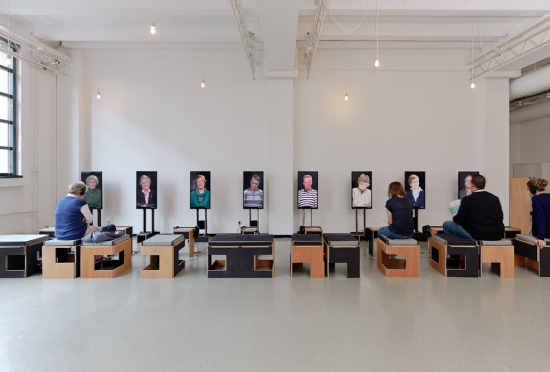
Mats Staub’s 21 – Memories of Growing Up. Photo: courtesy of the Noorderzon Festival.
The Noorderzon Festival also presented some fascinating installations, such as 21 – Memories of Growing Up, by Mats Staub, a Swiss artist, born in 1972, who works between Berlin and Zurich and whose projects combine theatre, exhibition, and journalism. Memories of Growing Up tackles the problem of time passing and its perception, confronting the audience with a multiplicity of personal stories of people born between 1939 and 1993. Mats Staub asked seventy people to narrate what they were like when they were twenty-one years old and what events helped them to become an adult. Their narrations were recorded, and three months later, the participants had to listen to what they had said, and this time they were video recorded, in close-ups, while they were listening to their own narration. The people were from diverse geographic origins—Germany, France, Netherlands, Slovakia, the United Kingdom, Austria, Switzerland, South Africa, Poland, the United States, the Congo, Russia—and also from different backgrounds.
The videos, with the participants’ faces, were projected onto fifteen vertical screens, with two seats in front of each of them, arranged in a semi-circle. In each seat, there were headphones where the spectator could listen to the narrations. When a spectator came into the space where the installation was located, he received a paper with the people’s names, with their birth date, listed under the number of the screen where their story could be heard. The audience heard the narration and also saw the faces with the reactions of the participants confronted with their own story, most of the time very surprised or moved by hearing what they had said, creating a strange distance between the person and the narration.
The narrations were not limited to a short period but usually exceeded their 21st birthday and explained what they were like at that time, how they acted, the most influential experiences for them, and how this period influenced them. The stories are most part very interesting, very personal, and seemingly sincere. Those fragments of life of those real people covered, in a very interesting way, a large part of the Twentieth Century. Each person’s recording lasts between six and eighteen minutes. The audience could move from one place to another, listening to as many stories as they wished, and even come back another day by asking for a new ticket when they leave. The installation was located at the top of the former water reservoir of Groningen City. To reach the top of this reservoir the audience had to take an outside elevator, where they were presented with a view of city and its outskirts, a very large spatial vision, before accessing a journey through the history of this area.
Among the dance productions, False Colored Eyes (Imploding Portraits Inevitable), presented by the group Liquid Loft, with choreography by Chris Haring, with music by Andreas Berger, and lighting technology by Thomas Jelinek was particularly interesting. This pleasant dance production presented a striking use of video technology and proposed a harsh criticism and a parody of the use of body images by some media. The set was composed of two screens in a large V position, its angle being at the furthest point from the audience. On stage, six dancers (Luke Baio, Stephanie Cumming, Katharina Meves, Ana Maria Nowak, Arttu Palmio, and Karin Pauer) began by making slow motion movements; there were three microphones and two video cameras.
The production dealt with individuals trying to get public attention with their body, using gestures and movements, very often clichés, such as those illustrated in fashion magazines, but also other seductive movements, much more provocative, with sexual connotation, elaborated from a choreographic point of view.
While some of the dancers moved, other dancers filmed them, and their images appeared simultaneously on the screen. The visual device used is the confrontation between real movements and their enlarged images projected on the screen, the real person appearing much smaller than its image, and often within the part of their body recorded. Most of the time, two or more split dancers were filmed with their images on the screen at the same time. The images showed the factitious character of the recorded images, for example when two characters, far from each other on stage, were projected as if they were close to each other, or when a woman was lying on the stage, filmed by two different cameras, and the upper side of the body and the legs were separated on the screen. At one point the actors filmed two open mouths, and two other actors danced in front of the image of two giant uvulas as though getting ready to be swallowed by them. The movements of the dancers were often repetitive, stressing their mechanical feature. The movements were often done at an accelerated pace, or on a few occasions, in slow motion, but many times they didn’t seem to have their natural pace.
Many images were close shots of a dancer, or of part of their body. Most of the time the faces of the dancers were inexpressive like those exposed in fashion magazines. In other sequences, they showed exaggerated cliché faces reminding the spectators of a precise feeling: anger, astonishment. There were many images of couples, evoking very affective visual intercourse. The dancers took off part of their clothes, without being naked, but the close shots magnified the body as well as the fake nakedness of it. At the same time, the images were mixed and multiplied in very different ways, evoking an Andy Warhol aesthetic, that the choreographer claimed to be inspired by. These very complex multiplications accentuated the parody of the use of the images. Without a plot, the production was based on variations, touching diverse aspects and attitudes of seduction, some ridiculous, some pathetic, some dramatic. The dancers sometimes said fragments of sentences, that could hardly be understood by the audience, as if the importance of the image and the accelerated rhythm did not leave any space for meaning even in a reduced and impoverished language. The electronic and repetitive music was present throughout the production, participating in its remarkable rhythm.
Very well crafted from a visual point of view, with a remarkable rhythm, the production unfolded the images, creating a real dramatic intensity, by the opposition between the dancers’ bodies on stage and their immediate transformation and reification into images for public intake. By doing this, the production stressed the artificiality of the audience’s attention, the culture of the body images to the detriment of the words, of articulated thought. By repetition, the image itself seemed simplified, transformed into clichés and emptied of any meaning.
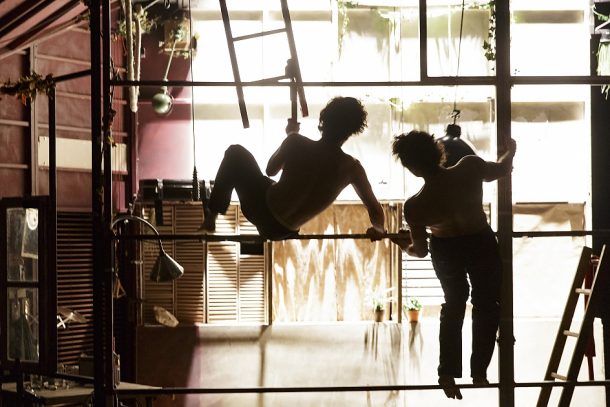
MPTA’s Barons Perchés, created by Mathurin Bolze. Photo: courtesy of the Noorderzon Festival.
The Noorderzon Festival also scheduled some high-quality popular productions of diverse genres such as productions close to the Nouveau Cirque. The French group Compagnie MPTA (Les Mains, les pieds et la tête aussi, or “the hands, the feet, and the head too”) fits within this last category. The group MPTA is based in the French city of Lyon. Their production Barons Perchés is an intelligent and a very pleasant production of Modern Circus, created by Mathurin Bolze. The title of their production is both an allusion to the Italo Calvino novel, and to the Marcel Aymé tale, Les contes du chat perché.
The set was formed by a structure of trapezoid form that featured a wooden shank with metallic structures and horizontal bars for the acrobats. It evoked the closed space of a house, but it was also an open space to the world both physically and metaphorically. At the bottom of this structure, there was a trampoline used by the acrobats for their spectacular movements. Barons Perchés used a character from previous productions, Bachir, played by Mathurin Bolze, but with also another acrobat, Karim Messaoudi. With physical similarities, they played like twins, or maybe an enigmatic double character, a fantastic double. The duplicity, from the start, was the reason for performing virtuosic acrobatics.
At the beginning the main character entered the home with a suitcase, but there was already somebody that appeared by a window and disappeared very quickly without being seen. Once they recognized each other, all seemed to be a competitive game. They appeared to pursue each other, jumping though the space, going out and coming back again, each time with more spectacular movements. Most of these were created by jumping on the trampoline. The acrobatic movements were presented as always being reactions, expressing diverse feelings towards the other character, which increased the pleasure of the audience which tried to recognize them. The story was enigmatic: there were few actions, but most of the tension of the production relied on the succession of double movements, performed by each acrobat, each time with variations, that created a mysterious relationship and a poetic complicity between the two. At some points, they seemed to want to leave the house but never succeeded. For a moment, one was disguised as a goose and the other acrobat wore a fox coat, imitating briefly their movements. Both went on the telephone trying to find a job. But nothing changed. The virtuosity of their movements was often hilarious, as when one of them reached the light suspended from the roof and remained stuck to the metallic structure suspended in emptiness. The music mixed with diverse noises of people and of the city that connected the house with the outside world. Compared to other acrobatic productions, there were not the usual pauses between the movements, during which the acrobats seemed to wait for the applause of the audience. In Barons Perchés, all the acrobatics follow each other without any pause, tied together by their strange and fraternal relationship, by the story, flowing without interruption for sixty minutes in front of an attentive audience. At the end, the two acrobats climbed together, slowly, to the top of their cabin, walked all over the roof, and descended also simultaneously to finish looking at the house, with their backs to the public.
There were also a few productions of children’s theatre, among them Les Soeurs (The Sisters), a beautiful, original and delicate puppet show, whose concept was created by Freija Van Esbroeck and Erki De Vries. This production by the Flemish group WIThWIT was shown at the Ophelia Tent, one of the theaters built in the Noorderplantsoen park. Along with technical achievements, it gave a tender metaphor of life and of nature. The set was at first covered by a white sheet, illuminated from behind and creating an image of theatre shadows. The structure had three vertical parts, with two levels, besides the central part which had one space. The first image showed the movement of a plant, downstage, in front of the white screen, drawn by a string invisible to the audience, across the stage until it went under the sheet: Nature was alive. When the screen was taken off, the audience could see plants hanging in every area that were used as counterweight for the two giant puppets, of around six meters high with two children’s faces, lying on the central area. Many times, the plants seem to be moving by themselves.
The puppeteers were the puppet servants, but also the image of the creators, with many affective movements on the part of the puppets, and the production showed the dependency of everyone. All the movements on stage were underlined by live guitar music, played by a musician who was on the first floor stage left: this gave a vivid rhythm to each little movement of the hand, the arm, as well as all the swift mood changes. The beauty of this production relied on the delicacy of the movements of the string puppets, their unseen dimensions, and the simultaneity of the music. The actions were many constant movements, but there was almost no story. One of the puppets awakened, began to move, stood up and then sat on a bench that was located on the second floor, showing its huge height. Besides their size, the movements preserved the frailty and the vulnerability of the string puppets. Then the second puppet also awakened, stood up, and also reached the same vertical position as her sister. They played together, held hands, and began to dance. Then the audience heard a sound like a little explosion and the second puppet collapsed on the floor, where it stayed motionless, illuminated by a red light, as if it were dead. The other puppet seemed to hesitate, not knowing what to do, and the puppeteers gather around, also looking surprised. One of them took a little plant and seemed to put it inside the back of the lying puppet. Nature helped it to recover its strength and it appeared to come back to life. Then the two puppets again danced together, flying, suspended in the air, what seemed like an exaltation of life, throughout the forty-five minutes of this production.
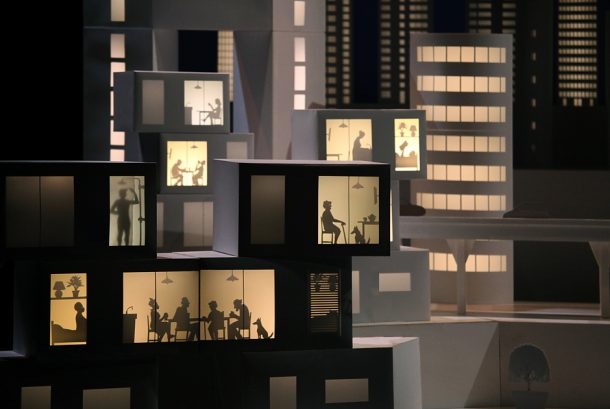
Les Ombres Portées’s Les Somnambules. Photo: courtesy of the Noorderzon Festival.
Les Somnambules, by the French Group Les Ombres Portées, was presented at the venue De Studio. This was a very nice and perfectly crafted shadow performance for children. The impressive set was composed of boxes of different sizes of geometric shape, that had a gray color when the audience came into the theatre: they represented an old city that is going to be demolished and that is already being replaced by a modern city. But as soon as the production began, most of the houses were illuminated from behind, showing the life of an entire city and its activity. Some little silhouettes moved on rails on the first level of the set, but most of the time they were shadows within the houses, or waiting for the subway, or the bus in the streets, or in cars crossing the set. Countless little articulated figures of adults, children, old people, all moving, represented life at different moments of the day, with its routine, with its effort, with the repetitive work of some. By switching the light on and off, different scenes are displayed: Early in the morning when they wake up, the working time, with little figures keying on computers on all the floors of a building, in the evening while they are all eating simultaneously. Often the light behind the figures moved, creating displacement of the shadows as if they were moving through the space as well as creating bigger figures like close-ups in the foreground. During the night moving shadows, for example of trees, occupied some of the buildings, like dreams or imaginary images that haunted the inhabitants of the city. Beautiful and impressive live saxophone, clarinet and violoncello music was played by two musicians down stage right; they also produced in front of the public many sounds like the wind, and raindrops, that gave a vivid rhythm to the production. In a nice pedagogic effort, following the production, the puppeteers showed the bewildered children and adults how it all worked behind the stage.
Among the children’s theatre productions, Listen to the Silence 6+ by the Zonzo Compagnie, directed by Letizia Renzini, with pianist Jeroen Malaises and actor Tjyying Liu, was another highlight of the festival. This production showed a concentrated vision of the universe set to music by John Cage. The music as well as many images, and the actions carried out by the actor and the pianist, refer to many of John Cage’s works and innovations: the production presents them directly, without explanation, just displaying them for children. It is based on diverse sequences in seemingly aleatory order.
The space is limited and small. The audience (mostly parents with their children) sat close to the actor and the pianist. The space was divided by a screen and the audience split into two groups, on either side of this screen. The actor was on one side of the space and the pianist was on the other, showing two aspects of John Cage’s activity, the performer and the composer. Images were projected onto the screen. On one side of the screen, the public saw the actors’ actions and the video images and heard the music. On the other side, the audience saw the musician playing the piano, the video, as well as the silhouette of the actor moving on the other side of the screen, as in a shadow theatre. On the screen, there was a door that allowed the actor to cross from one part to the other. At one point, the actor put on a helmet with a video camera on it, and its images were shown on the screen, reminding us that Cage not only did experiments, he also developed reflections on them. Throughout the production, the audience heard the music and saw the actor’s movements. At another point, the actor observes carefully with a light the image projected on the screen, evoking the importance of painting in John Cage’s work, or maybe Rauschenberg’s painting influence. At the beginning of the production, twelve metronomes were working on stage simultaneously, evoking one of the Cage experiments.
On the screen, one of the first images projected was a bird in jail, and the audience heard a bird’s song at the same time as the beat of the metronomes, alluding to Cage’s composition. A little later an image of a forest evokes the importance of the environmental world and nature as a model for Cage of indeterminacy and change. In the first part of the production, the actor’s movements evoked the image of a bird, with slow and controlled movements, suggesting Cage’s fascination with the calm and peace of Buddhism.
Both the actor and the musician interacted with the children like a game, with a sense of humor. The musician, for instance, asked them to come with him and to put things inside of the piano, to directly touch the piano strings or to throw ping pong balls inside of the piano, evoking Cage’s work with prepared pianos: the audience heard the transformation of the piano’s sounds. Their interventions created an aleatory music, a tension between diverse sounds, desired or not, that Cage sought very often, showing his rejection of traditional harmony. At one point, the actor gave three radios to children, who moved with them across the stage, reminding us of Cage’s experimentations with radios and noises coming from different points of the venue.
At one point, the actor changed clothes and put on a lab coat; on the lateral section of the screen, images of machines were shown. Looking like an inventor, stressing the innovative facet of John Cage’s work, the actor made different noises with objects: a pouring water sound, boiling water, scratching of plastic bottles, the noise of plastic bags, the noise of air expelled from a balloon, the noise of a mixer; later on, the actor moved a chair, producing a scratching sound on the floor. The noises were also mixed with electronic music that John Cage developed.
Playing with the opposition between words and images, sentences appeared on screen as written on different pieces of paper, reminding us of some famous comments on John Cage’s life: “I remember I have no talent for the music,” “I remember that as a child I liked all sounds” “I remember saying the sound experience which I prefer is the experience of silence.” On the screen, colorful images that suggested Cage’s painting were shown, but also animated images, such as psychedelic mushrooms moving, with diverse form and color, recalling Cage’s love for foraging mushrooms. Then part of the screen was taken away and the audience could see the entire room and the public on the other side. The actor sang and the sound of his voice was transformed by a reverberation effect. At the end of the production, the pianist, seated on a small platform, played a little piano while the actor pulled it around the stage and exited.
Manuel García Martinez is Senior Lecturer in French Literature at the University of Santiago de Compostela. He wrote his Ph.D. in Drama Studies at University Paris 8. His research interests are time and rhythm in theatrical productions/performances and in dramatic texts, the French contemporary theatre, and the Canadian theatre.
European Stages, vol. 8, no. 1 (Fall 2016)
Editorial Board:
Marvin Carlson, Senior Editor, Founder
Krystyna Illakowicz, Co-Editor
Dominika Laster, Co-Editor
Kalina Stefanova, Co-Editor
Editorial Staff:
Cory Tamler, Managing Editor
Mayurakshi Sen, Editorial Assistant
Advisory Board:
Joshua Abrams
Christopher Balme
Maria Delgado
Allen Kuharsky
Bryce Lease
Jennifer Parker-Starbuck
Magda Romańska
Laurence Senelick
Daniele Vianello
Phyllis Zatlin
Table of Contents:
- The 70th Avignon Festival: An Experiment In Living Together by Philippa Wehle
- The 2016 Berlin Theatertreffen: Is Half a Festival Better Than None? by Marvin Carlson
- Introduction au Kunstenfestivaldesarts de Bruxelles 2016 by Manuel García Martínez
- The Fidena Festival, 2016 by Roy Kift
- The Noorderzon Festival in Groningen by Manuel García Martínez
- Review of The Suicide by Steve Earnest
- Spain: Runaway Hits and Ephemeral Memorabilia by Maria M. Delgado
- The Seagull: An Idea for a Short Story by Emiliia Dementsova
- Billy Elliot The Musical at the Hungarian State Opera by James Wilson
- Chorus of Orphans: A Theatre Séance by Poland’s Teatr KTO, Kraków by Jacob Juntunen
- Theatre More Arresting than Ever: A Conversation with Dorota Masłowska by Krystyna Lipinska Illakowicz
Martin E. Segal Theatre Center:
Frank Hentschker, Executive Director
Marvin Carlson, Director of Publications
Rebecca Sheahan, Managing Director
©2016 by Martin E. Segal Theatre Center
The Graduate Center CUNY Graduate Center
365 Fifth Avenue
New York NY 10016



